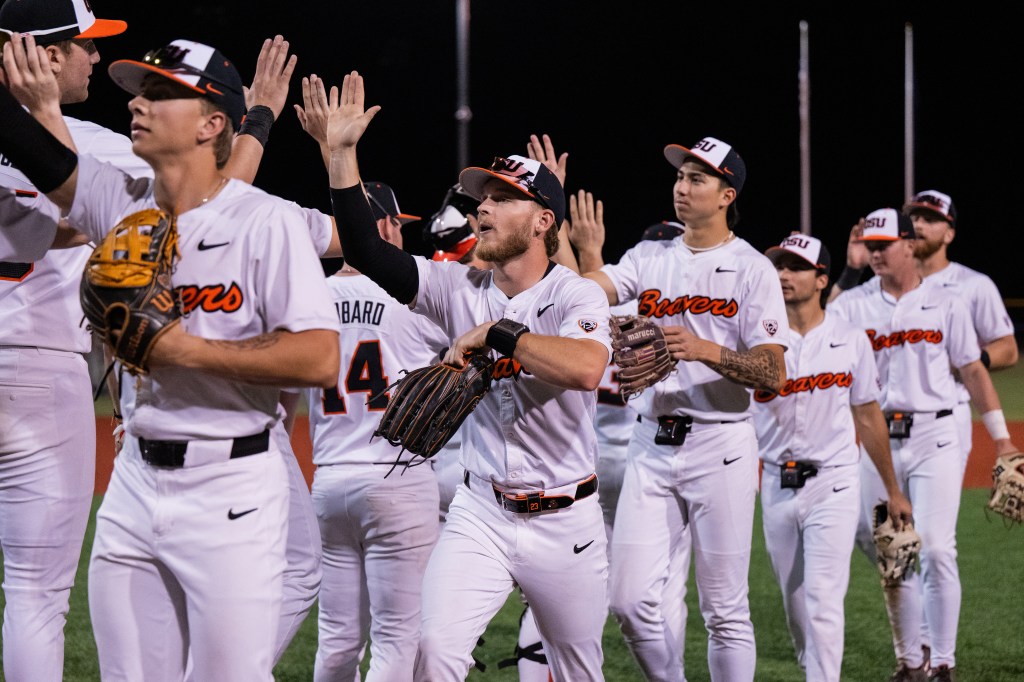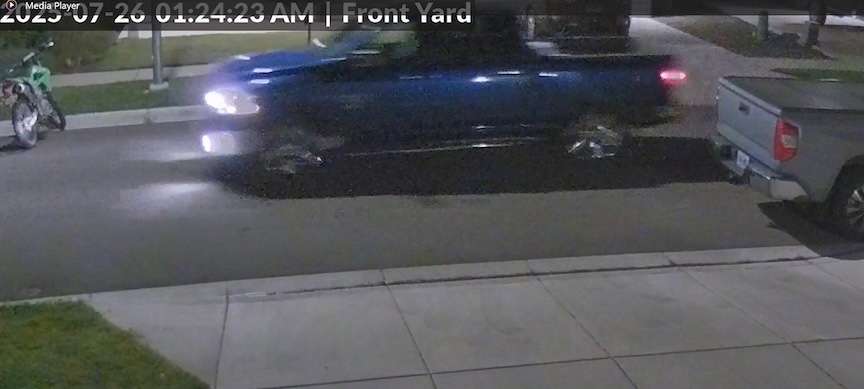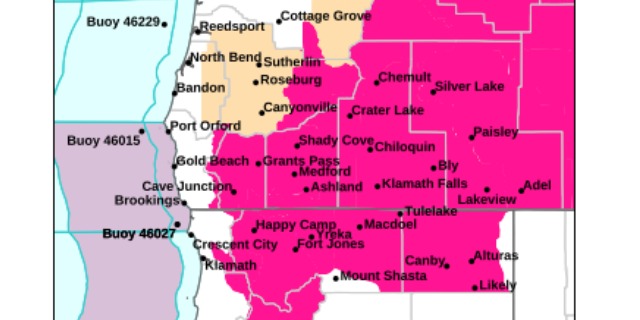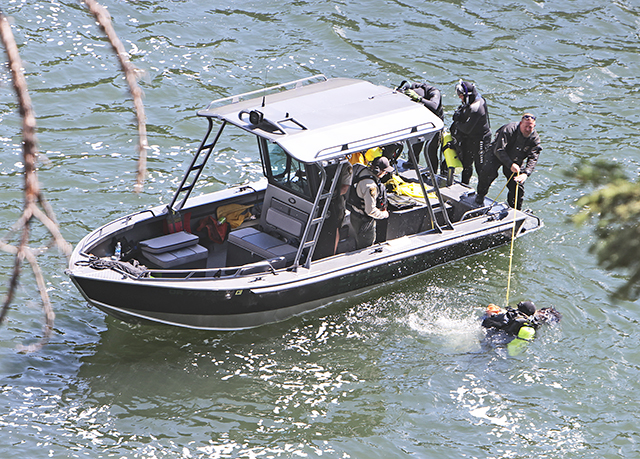What to expect from Oregon State baseball vs. Florida State in super regionals
Published 4:06 pm Thursday, June 5, 2025

- The Oregon State Beavers celebrate their 5-2 victory over Washington at Hillsboro Ballpark on March 25, 2025. The Beavers will host their eighth-ever super regional against Florida State, with a trip to the College World Series on the line
The 2025 Corvallis Super Regional is here, with No. 8 Oregon State baseball (45-13-1) set to take on No. 9 Florida State (41-14) in a best-of-three series at Goss Stadium beginning Friday.
With a trip to Omaha on the line, Corvallis plays host to two non-SEC college baseball powerhouses in the 21st century.
The Seminoles enter on a three-game winning streak, barreling through the Tallahassee Regional with a 3-0 record last weekend, and have more supers experience than any team in America with 19 appearances since the format began in 1999. In year three of head coach Link Jarrett’s tenure, FSU is making its second-consecutive appearance in a super regional (swept UConn in Tallahassee) after making the College World Series last season. The Noles are 12-2 in the postseason under Jarrett.
Trending
The Beavers will take the field on their own four-game winning streak, putting together a stunning comeback in the Corvallis Regional after a game one loss to four-seed Saint Mary’s. Behind a +42 run-differential, Oregon State became the first top-eight seed since 2014 Louisiana to advance to a super after dropping game one of its regional. The Beavers are appearing in their third super regional in head coach Mitch Canham’s six-year tenure and hosting for the second time (2022). They hold a 16-12 postseason record, 11-4 at home, under Canham, but have not reached the College World Series since winning it in 2018.
How to Watch
The schedule for the Corvallis Super Regional between the Oregon State Beavers and Florida State Seminoles is as follows:
Game one: 3 p.m. on Friday, June 6 (ESPN2, ESPN+)
Game two: 6 p.m. on Saturday, June 7 (ESPN2, ESPN+)
Game three (if necessary): start time TBD, Sunday, June 8 (Broadcast partner TBD)
Scouting Florida State
Starting pitching
The Seminoles are headlined by a pair of future first-round draft selections in ace starting pitcher Jamie Arnold (No. 5 prospect, No. 1 LHP on Baseball America’s top-500) and shortstop Alex Lodise (BA’s No. 26 prospect, No. 4 college SS) with ample talent to boot. Lodise was named the Atlantic Coast Conference’s player of the year and defender of the year, while Arnold and second baseman Drew Faurot joined him as all-ACC first team selections. Florida State produced seven all-ACC selections across the first, second, third and freshmen teams.
Trending
Arnold (8-2, 78 IP, 3.12 ERA) headlines a three-man starting rotation, all of which are left-handed. With Arnold, a junior, typically getting the ball Fridays, redshirt junior Joey Volini (8-5, 80.2 IP, 3.68 ERA) going Saturdays and sophomore Wes Mendes (7-2, 77.1 IP, 4.66 ERA) on the bump in FSU’s gold uniforms on Sundays.
Jarrett and the FSU coaching staff have yet to announce starters for the super regional and their individual deployment may be adjusted with Volini (BA’s No. 298) pitching three innings (5 H, 2 R, 0 BB, 2 Ks) in a 6-2 win over Bethune Cookman on Friday, while Arnold struck out 13 and allowed three runs over seven frames in the Noles 10-3 win over Mississippi State on Saturday. Mendes (BA’s No. 27 for the 2026 class) mopped up the Bulldogs, striking out nine and allowing two runs on three hits over eight innings of work in Sunday’s 5-2 win.
Arnold’s calling card is an upper-90s fastball from a sidearm slot with a wipeout slider he’ll throw to both lefties and righties, also working in a changeup. Volini’s fastball sits in the low 90s, mixing a curveball, slider and changeup as secondary offerings. Mendes, the youngest of the three, leans heavily on a low-90s fastball with a high-70s changeup to play off of it.
Bullpen arms
What FSU lacks in right-handed starters, it makes up for out of the bullpen.
Of six arms with 20-or-more relief innings, five (Peyton Prescott, Joe Charles, John Abraham, Chris Knier and Maison Martinez) are right-handed, with Payton Manca the lone southpaw.
While the Seminoles 13 saves have been distributed amongst six arms, Charles, a redshirt senior, is the clubhouse leader with four, holding a 3.82 ERA while opposing hitters have batted just .183 against him in 33 innings. Charles leads the bullpen in both stats, while the remaining five hold an average ERA of 5.22 and strikeout more than one batter per inning.
Lineup
Like Oregon State, the Seminoles deployed essentially the same lineup all three days of their regional, with the lone platoons coming behind the dish in the nine-hole and the designated-hitter spot in the eight-hole:
RF — Gage Harrelson, L/L (.335)
SS — Alex Lodise, R/R, SS (.405)
CF — Max Williams, L/L, CF (.318)
1B — Myles Bailey, L/R, 1B (.328)
3B — Cal Fisher, R/R, 3B (.310)
2B — Drew Faurot, S/R, 2B (.308)
LF — Chase Williams, S/R, LF (.350)
DH — James Hankerson Jr., S/L (.256) -OR- Brody Delamuelleure, R/R (.248)
C — Jaxson West, L/R (.241) -OR- Hunter Carns, R/R (.266)
Along with his ACC hardware, Lodise is firmly in the conversation for the Golden Spikes Award and has wreaked havoc on opposing pitching all season with 92 hits, 17 home runs and 1.209 OPS as a junior. Williams, Bailey and Faurot all join Lodise in the double-digit home runs category, with the Seminoles bashing 100 so far this season.
Looking at how Florida State’s lineup does splits-wise, the Seminoles are balanced against lefties and righties two-through-five. A handful of splits, however, give some insight into how FSU will structure its lineup and how the Beavers will want to attack it pitching-wise.
All 12 listed above have roughly 100 fewer at-bats against lefties than they do righties, but Lodise (.947 SLG vs. LHP), Farout, Delamuelleure and both catchers mash southpaws. Hankerson Jr. (.286 BA vs. RHP, .167 vs. LHP) serves as the right-handed side of the DH platoon, performing significantly better against righties than Dellamuelleure. Carns (.258 BA vs. RHP) is better against lefties, but is better than platoon-mate West (.196 BA) with a right-hander on the hill.
Leadoff man Gage Harrelson and the switch-hitting Faurot are both .300-hitters against lefties or righties, but both hit left-handed pitching around 50 points better. Third baseman Cal Fisher is the inverse of the aforementioned pair, with the right-handed sophomore putting up reverse splits, hitting .250 vs. LHP and .331 against RHP.
How will Oregon State fair?
Hitting the lefties
Left-handed pitching has been a major bugaboo for the Beavers this season.
Junior outfielder Gavin Turley is the only right-handed hitter on Oregon State’s roster to perform better against lefties (1.143 OPS vs. LHP) than righties (.991 OPS vs. RHP) over the course of the season. The rest of Oregon State’s lineup, including cornerstone pieces like catcher Wilson Weber and shortstop Aiva Arquette, are reverse split players. First baseman Tyce Peterson is the most glaring example, batting .122 against lefties and .337 against righties.
Florida State’s entirely left-handed rotation including Arnold, arguably the best southpaw in the nation, isn’t a great look for the Beavers. But as head coach Mitch Canham would tell you, stats go out the window in the postseason. Part of Oregon State’s success in the Corvallis Regional was its ability to consistently hit left-handed pitching for the first time this year. The sample sizes are small, with just five games to look at, but the numbers were drastic.
Arquette put up a 1.445 OPS in 10 at-bats against lefties over the regional weekend, with players like Peterson and Easton Talt (the lone left-handed hitter to eclipse 150 at-bats for the Beavers) mashing lefties as well. Factor in Turley’s dominance against either and third baseman Trent Caraway morphing into some sort of lab-grown Tony Gwynn-Barry Bonds hybrid for five games and suddenly Oregon State looks like its sorted out its left-handed woes — sample-size (and Jamie Arnold) beware.
Pitching to FSU
Similarly, pitching coach Rich Dorman’s rotation and bullpen threw the ball over regional weekend the best they had all season.
Aside from right-hander Eric Segura’s Friday blow up, the staff looked increasingly dominant with every new arm that took the hill. The Beavers are also flush with right-handed talent and, playing a maximum three games as opposed to five, will have more of it at their disposal. Junior Nelson Keljo and sophomore Ethan Kleinschmit may fall victim to the Seminoles’ dominance against lefties, but depth of right-handed options like Wyatt Queen, Kellan Oakes and Laif Palmer can give Oregon State plenty of flexibility.
The skinny
The fate of both teams looks like it will come down to who can platoon-hit better.
At the plate, Oregon State will have to hope it can carry over some of its success against left-handed pitching from regional weekend and force Florida State to get into its right-handed heavy bullpen, while the pitching staff gives an encore performance from the previous weekend. If the Beavers can’t chase Arnold, Volini or Mendes off early — or at least run pitch-counts up early — the series could be a short one for Oregon State.
The same will be true for Florida State, whose perfect world would be deep innings from each of their starters. The Seminoles have seen good pitching in the ACC, but the Beavers — who’s ceiling (and floor) is still somewhat a mystery without many east-of-the-Mississippi matchups this season — looked like the deepest staff in America this past weekend. If Oregon State can get those encore performances out of its rotation and bullpen, Mitch Canham will have a chance to lead his team to Omaha for the first time since he had catcher’s gear on.








